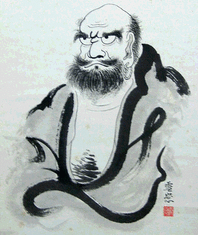History
Legend credits the refinement of Tai Chi practices established by Ta Mo to Chang San-feng, who lived in the Sung Dynasty (960 to 1279 AD) around 1247 AD. According to these stories, he heard an unusual noise outside in his courtyard, and looking down from his window saw a crane and snake fighting. The crane attacking with its sword-like beak and the snake in turn twisting and bending and staying out of reach then counter attacking, the crane then raising its leg and lowering its wing. In this he saw the Tao (Way) or Yin-Yang principle (Tai Chi). The strong, changing to the yielding and the yielding, changing to the strong.
Brief History/Mythology of Tai Chi Chuan

The most widely held belief is that Tai Chi Chuan was devised by Chang San-feng, a renowned Taoist teacher who is thought to have lived during the 13th Century, spending part of his life in the remote Wudang Mountains. Today Wudang mountain is a pilgrimage destination for Taoists and tourists and there remain statues of Chang San-feng in temples on the mountain. He is said to have learned T'ai Chi Ch'uan in a dream, or after watching a bird and a snake fight. More likely, Chang applied the Taoist health principles and knowledge of energy circulation to his vast ability in external kung fu, thus creating something really different - a martial art that dos not use muscle power as a primary source of movement, but Chi. Records available in the monastery on Wu Tang Mountain do indeed mention him. Descriptions picture him as being seven feet tall, with the bones of a crane and the posture of a pine tree, whiskers shaped like a spear, and in winter and summer wearing the same bamboo hat, carrying a horsehair duster and being able to cover 1000 Li in a day.

The crane - snake combat gave him the ideas that the coiled movement of the snake was like the Taijitu (the Yin / yang symbol) and contained the principle of the soft overcoming the hard. Based upon the transformations of the Grand Ultimate, the Yin and Yang leading to the Bagua eight Trigrams, the Trigrams leading the 10.000 things (everything), and the Wuxing (Five movements or phases) being the basis of their interaction, he developed Taijiquan, to gather the Qi, cultivate it to Jing (essence), and hence transform it into Shen (spirit); all waxing and waning, movement and stillness, action and non-action embodied in the I-ching.
Tai Chi Chuan
In the 17th century a student of the Wudang Mountain School, Chiang Fa, taught the principles of Nei Chia to the villagers of a town in Honan province - almost all of whom were called Chen. Thus began the first family school of Tai Chi Chuan (Chen Style).
In the 17th century a student of the Wudang Mountain School, Chiang Fa, taught the principles of Nei Chia to the villagers of a town in Honan province - almost all of whom were called Chen. Thus began the first family school of Tai Chi Chuan (Chen Style).
|

In the sixth century AD the Indian Buddhist monk Bodhidharma (Ta Mo) came to the Shao-lin Monastery in an effort to transmit the Cha'n (Zen) meditation tradition to China. Seeing that the monks there were in poor health he taught them the 18 Buddha Hand Exercises to improve their physical condition and assist them in their meditation. Over time this developed into the original Shao-lin system of Kung Fu and the precursors of the Wei Chia (External) and Nei Chia (Internal) schools of Kung Fu. What is common to all internal styles of Kung Fu are Chi Kung, and martial arts practice based on natural principles and meditation. From this he identified the same concept in water, the movement of animals, clouds and trees in the wind. He then created forms based on these movements and adapted the Shao-lin martial forms that he had previously learned to the idea of Taoist meditation. His practices are part of the foundation of the Taoist Wudang Mountain School that stands in contrast to Buddhist Shao-lin tradition. From here the three main internal systems of Tai Chi Chuan, Bagua, and Hsing-yi have connection with the Shaolin Monastery.



